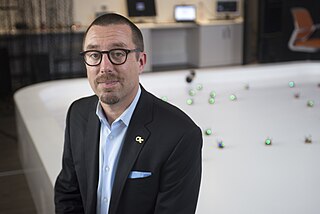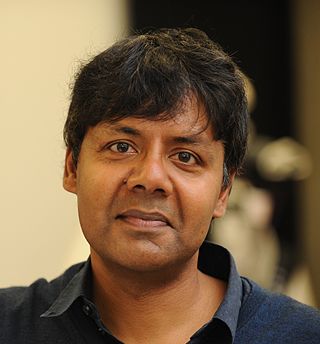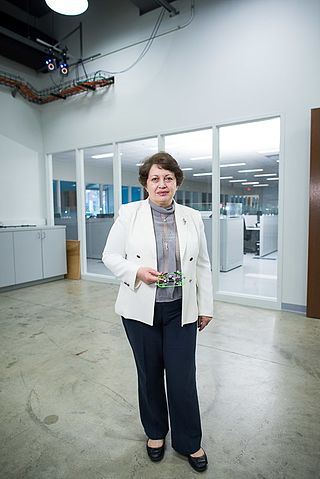Robot learning is a research field at the intersection of machine learning and robotics. It studies techniques allowing a robot to acquire novel skills or adapt to its environment through learning algorithms. The embodiment of the robot, situated in a physical embedding, provides at the same time specific difficulties and opportunities for guiding the learning process.

Thomas Shi-Tao Huang was a Chinese-born American computer scientist, electrical engineer, and writer. He was a researcher and professor emeritus at the University of Illinois at Urbana-Champaign (UIUC). Huang was one of the leading figures in computer vision, pattern recognition and human computer interaction.
Richard Blahut, former chair of the Electrical and Computer Engineering Department at the University of Illinois at Urbana–Champaign, is best known for his work in information theory. He received his PhD Electrical Engineering from Cornell University in 1972.

Linda G. Shapiro is a professor in the Department of Computer Science and Engineering, a professor of electrical engineering, and adjunct professor of Biomedical Informatics and Medical Education at the University of Washington.

Magnus B. Egerstedt is a Swedish-American roboticist who is the Dean of the Henry Samueli School of Engineering at the University of California, Irvine. He was formerly the Steve C. Chaddick School Chair and Professor at the School of Electrical and Computer Engineering, Georgia Institute of Technology.
Bir Bhanu is the Marlan and Rosemary Bourns Endowed University of California Presidential Chair in Engineering, the Distinguished Professor of Electrical and Computer Engineering, and Cooperative Professor of Computer Science and Engineering, Mechanical Engineering and Bioengineering, at the Marlan and Rosemary Bourns College of Engineering at the University of California, Riverside (UCR). He is the first Founding Faculty of the Marlan and Rosemary Bourns College of Engineering at UCR and served as the Founding Chair of Electrical Engineering from 1/1991 to 6/1994 and the Founding Director of the Center for Research in Intelligent Systems (CRIS) from 4/1998 to 6/2019. He has been the director of Visualization and Intelligent Systems Laboratory (VISLab) at UCR since 1991. He was the Interim Chair of the Department of Bioengineering at UCR from 7/2014 to 6/2016. Additionally, he has been the Director of the NSF Integrative Graduate Education, Research and Training (IGERT) program in Video Bioinformatics at UC Riverside. Dr. Bhanu has been the principal investigator of various programs for NSF, DARPA, NASA, AFOSR, ONR, ARO and other agencies and industries in the areas of object/target recognition, learning and vision, image/video understanding, image/video databases with applications in security, defense, intelligence, biological and medical imaging and analysis, biometrics, autonomous navigation and industrial machine vision.

Rashid Bashir is Dean of The Grainger College of Engineering, Grainger Distinguished Chair in Engineering and Professor of Bioengineering, at the University of Illinois at Urbana-Champaign. He was the Executive Associate Dean and Chief Diversity Officer at the Carle-Illinois College of Medicine at UIUC. Previously, he was the Abel Bliss Professor of Engineering, Head of Department of Bioengineering, Director of the Micro and Nanotechnology Laboratory, and Co-Director of the campus-wide Center for Nanoscale Science and Technology, a "collaboratory" aimed at facilitating center grants and large initiatives around campus in the area of nanotechnology. Prior to joining UIUC, he was at Purdue University from 1998–2007 with faculty appointments in Electrical and Computer Engineering, and Bioengineering. From 1992 to 1998 he worked at National Semiconductor Corporation in Santa Clara, CA as Sr. Engineering Manager. He graduated with a PhD in Electrical Engineering from Purdue University in 1992. He has authored or co-authored over 240 journal papers, over 200 conference papers and conference abstracts, and over 120 invited talks, and has been granted 50 patents. He is an NSF Faculty Early Career Award winner and the 2012 IEEE EMBS Technical Achievement Award. He received the Pritzker Lecture Award from BMES in 2018. He is a fellow of IEEE, AIMBE, AAAS, BMES, RSC, APS, and NAI.

Rob A. Rutenbar is an American academic noted for contributions to software tools that automate analog integrated circuit design, and custom hardware platforms for high-performance automatic speech recognition. He is Senior Vice Chancellor for Research at the University of Pittsburgh, where he leads the university's strategic and operational vision for research and innovation.
John R. Tucker was an American physicist who made several contributions to the fields of electronics, physics and microwave theory, known for generalizing the microwave mixer theory and presenting the body of work, known as the "Tucker theory", and for his fundamental theoretical contributions which resulted into various advancements in experimental Submillimeter astronomy. He is also credited with laying down some of the technological foundations for making practical Quantum computing possible.

Bruce Edward Hajek is a Professor in the Coordinated Science Laboratory, the head of the Department of Electrical and Computer Engineering, and the Leonard C. and Mary Lou Hoeft Chair in Engineering at the University of Illinois Urbana–Champaign. He does research in communication networking, auction theory, stochastic analysis, combinatorial optimization, machine learning, information theory, and bioinformatics.

Sethu Vijayakumar FRSE is Professor of Robotics at the University of Edinburgh and a judge on the BBC2 show Robot Wars. He is the Programme co-Director for Artificial Intelligence at The Alan Turing Institute, the UK's National Institute for Data Science and Artificial Intelligence, with the responsibility for defining and driving the institute's Robotics and Autonomous Systems agenda. He co-founded the Edinburgh Centre for Robotics in 2015 and was instrumental in bringing the first NASA Valkyrie humanoid robot out of the United States of America, and to Europe, where is it a focus of research at the School of Informatics. He was elected as a Fellow of the Royal Society of Edinburgh in 2013.
Shun Lien Chuang was a Taiwanese-American electrical engineer, optical engineer, and physicist. He was a Fellow of the IEEE, OSA, APS and JSPS, and professor at the University of Illinois at Urbana-Champaign.

Naira Hovakimyan is an Armenian control theorist who holds the W. Grafton and Lillian B. Wilkins professorship of the Mechanical Science and Engineering at the University of Illinois at Urbana-Champaign. She is the director of AVIATE Center of flying cars at UIUC, funded through a NASA University Leadership Initiative. She was the inaugural director of the Intelligent Robotics Laboratory during 2015–2017, associated with the Coordinated Science Laboratory at the University of Illinois at Urbana-Champaign.
Paris Smaragdis is a computer scientist noted for his contributions to audio signal processing, computer audition, and machine learning. He is currently an associate professor of computer science at the University of Illinois at Urbana-Champaign, Illinois. He currently holds over 35 patents in the areas of audio signal processing and machine learning.

Stephen John Young is a British researcher, Professor of Information Engineering at the University of Cambridge and an entrepreneur. He is one of the pioneers of automated speech recognition and statistical spoken dialogue systems. He served as the Senior Pro-Vice-Chancellor of the University of Cambridge from 2009 to 2015, responsible for planning and resources. From 2015 to 2019, he held a joint appointment between his professorship at Cambridge and Apple, where he was a senior member of the Siri development team.
Karl Hess is the Swanlund Professor Emeritus in the Department of Electrical and Computer Engineering at the University of Illinois at Urbana–Champaign (UIUC). He helped to establish the Beckman Institute for Advanced Science and Technology at UIUC.

Stephen A. Boppart is a principal investigator at the Beckman Institute for Advanced Science and Technology at the University of Illinois at Urbana-Champaign, where he holds an Abel Bliss Professorship in engineering. He is a faculty member in the departments of electrical and computer engineering, bioengineering, and internal medicine. His research focus is biophotonics, where he has pioneered new optical imaging technologies in the fields of optical coherence tomography, multi-photon microscopy, and computational imaging.
Xiuling Li is an distinguished electrical and computer engineering professor in the field of nanostructured semiconductor devices. She is currently the Temple Foundation Endowed Professorship No. 3 in Electrical and Computer Engineering and Fellow of the Dow Professor in Chemistry at the University of Texas at Austin. Previously, she was a Donald Biggar Willet Professor in Electrical and Computer Engineering and Interim Director of the Nick Holonyak Jr. Micro and Nanotechnology Laboratory at the University of Illinois at Urbana-Champaign.
Chin-Hui Lee is an information scientist, best known for his work in speech recognition, speaker recognition and acoustic signal processing. He joined Georgia Institute of Technology in 2002 as a professor in the school of electrical and computer engineering
Wang Gang, also known as Michael Wang, is an electrical and computer engineer and academic specializing in Artificial Intelligence and its application in autonomous driving. Wang has authored or co-authored more than 100 publications, cited over 28,000 times. His h-index is computed to be 72.









